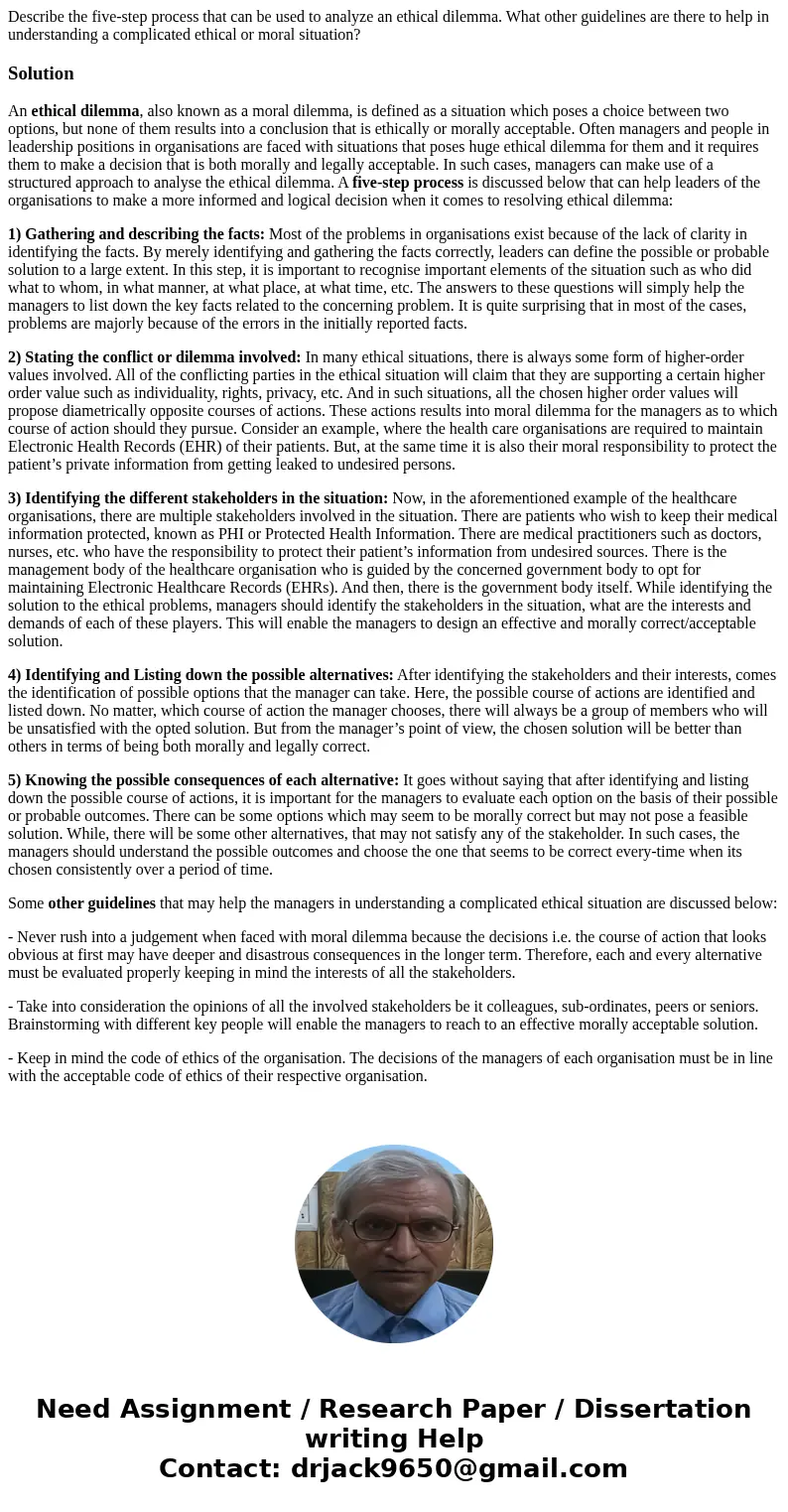Describe the fivestep process that can be used to analyze an
Describe the five-step process that can be used to analyze an ethical dilemma. What other guidelines are there to help in understanding a complicated ethical or moral situation?
Solution
An ethical dilemma, also known as a moral dilemma, is defined as a situation which poses a choice between two options, but none of them results into a conclusion that is ethically or morally acceptable. Often managers and people in leadership positions in organisations are faced with situations that poses huge ethical dilemma for them and it requires them to make a decision that is both morally and legally acceptable. In such cases, managers can make use of a structured approach to analyse the ethical dilemma. A five-step process is discussed below that can help leaders of the organisations to make a more informed and logical decision when it comes to resolving ethical dilemma:
1) Gathering and describing the facts: Most of the problems in organisations exist because of the lack of clarity in identifying the facts. By merely identifying and gathering the facts correctly, leaders can define the possible or probable solution to a large extent. In this step, it is important to recognise important elements of the situation such as who did what to whom, in what manner, at what place, at what time, etc. The answers to these questions will simply help the managers to list down the key facts related to the concerning problem. It is quite surprising that in most of the cases, problems are majorly because of the errors in the initially reported facts.
2) Stating the conflict or dilemma involved: In many ethical situations, there is always some form of higher-order values involved. All of the conflicting parties in the ethical situation will claim that they are supporting a certain higher order value such as individuality, rights, privacy, etc. And in such situations, all the chosen higher order values will propose diametrically opposite courses of actions. These actions results into moral dilemma for the managers as to which course of action should they pursue. Consider an example, where the health care organisations are required to maintain Electronic Health Records (EHR) of their patients. But, at the same time it is also their moral responsibility to protect the patient’s private information from getting leaked to undesired persons.
3) Identifying the different stakeholders in the situation: Now, in the aforementioned example of the healthcare organisations, there are multiple stakeholders involved in the situation. There are patients who wish to keep their medical information protected, known as PHI or Protected Health Information. There are medical practitioners such as doctors, nurses, etc. who have the responsibility to protect their patient’s information from undesired sources. There is the management body of the healthcare organisation who is guided by the concerned government body to opt for maintaining Electronic Healthcare Records (EHRs). And then, there is the government body itself. While identifying the solution to the ethical problems, managers should identify the stakeholders in the situation, what are the interests and demands of each of these players. This will enable the managers to design an effective and morally correct/acceptable solution.
4) Identifying and Listing down the possible alternatives: After identifying the stakeholders and their interests, comes the identification of possible options that the manager can take. Here, the possible course of actions are identified and listed down. No matter, which course of action the manager chooses, there will always be a group of members who will be unsatisfied with the opted solution. But from the manager’s point of view, the chosen solution will be better than others in terms of being both morally and legally correct.
5) Knowing the possible consequences of each alternative: It goes without saying that after identifying and listing down the possible course of actions, it is important for the managers to evaluate each option on the basis of their possible or probable outcomes. There can be some options which may seem to be morally correct but may not pose a feasible solution. While, there will be some other alternatives, that may not satisfy any of the stakeholder. In such cases, the managers should understand the possible outcomes and choose the one that seems to be correct every-time when its chosen consistently over a period of time.
Some other guidelines that may help the managers in understanding a complicated ethical situation are discussed below:
- Never rush into a judgement when faced with moral dilemma because the decisions i.e. the course of action that looks obvious at first may have deeper and disastrous consequences in the longer term. Therefore, each and every alternative must be evaluated properly keeping in mind the interests of all the stakeholders.
- Take into consideration the opinions of all the involved stakeholders be it colleagues, sub-ordinates, peers or seniors. Brainstorming with different key people will enable the managers to reach to an effective morally acceptable solution.
- Keep in mind the code of ethics of the organisation. The decisions of the managers of each organisation must be in line with the acceptable code of ethics of their respective organisation.

 Homework Sourse
Homework Sourse